Sketchbooks don’t have to be boring; there are tons of ways to keep things fun and creative! Try quick gesture drawings, invent fantasy animals, play with color palettes, or stick magazine scraps for wild collages. Study flowers, doodle your favorite snacks, fill a page with funky textures, or sketch city street scenes. Self-portraits can get goofy, and one-minute drawing sprints make things exciting. With so many ideas, there’s always something new to spark your imagination—keep going to find your next favorite!
Key Takeaways
- Practice one-minute gesture sketches of people or animals to boost speed, observation, and energy in your drawing.
- Create color palette swatches inspired by your environment to explore different mood and style possibilities.
- Fill a page with texture experiments using mixed media to capture bumpy, scratchy, and soft surfaces around you.
- Arrange everyday objects for a still-life study, focusing on light, shadow, and unique viewpoints.
- Invent fantasy creatures by mixing real animal features, encouraging playfulness and imaginative anatomy studies.
Still Life Setups From Everyday Objects
Even though sketchbooks can sometimes feel intimidating—just a bunch of empty pages staring back with a big “draw something cool!” vibe—still life setups from everyday objects are a fantastic way to kickstart creativity.
Grab anything: an apple, a mug, some old headphones, or even your favorite snack. Arrange them in a cool way, paying attention to how the light hits them and where shadows lurk.
Still life doesn’t mean you have to be fancy—pick objects you like or have a story behind. Try drawing the same still life from different angles: boom, instant variety!
Limiting your colors or sticking to pencil helps you focus on shapes and shadows, not just color chaos. Set a timer and sketch fast; it’s about capturing the mood, not perfection.
Nature Studies: Leaves, Flowers, and Insects
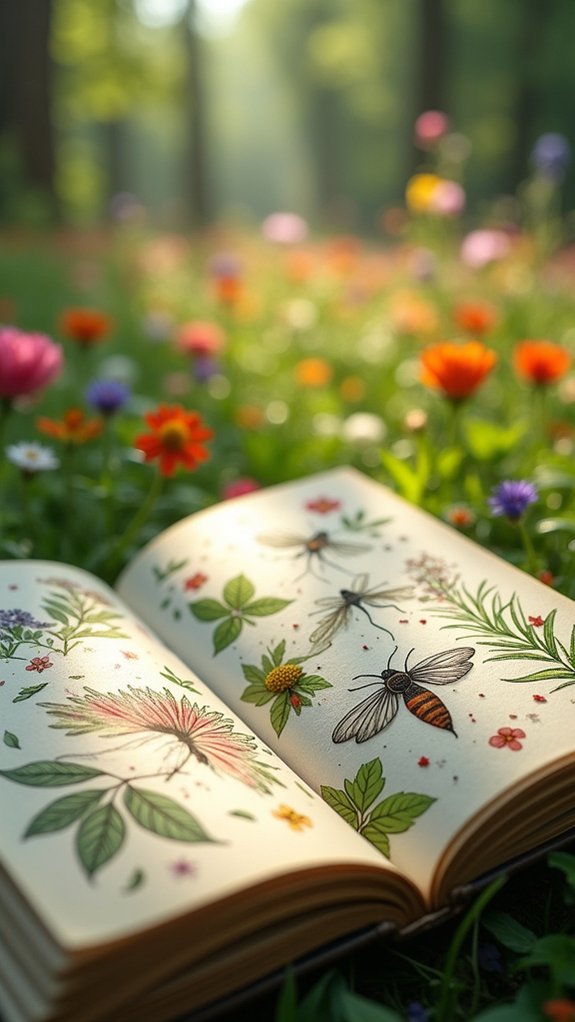
Nature studies in your sketchbook let you zoom in on all those wild little details—think swirling veins on a leaf, the fuzz on a bee’s body, or the way petals look almost like crumpled paper.
Getting up close to leaves and bugs means paying extra attention to their shapes and textures, which isn’t just fun but also super useful for sharpening your drawing skills.
Don’t forget to try different lines and shading tricks to capture the surprising patterns and textures you find, because nature has way more personality than you’d expect!
Observing Botanical Details
Although it might sound like something only scientists do, observing botanical details is actually a super fun way for artists to dig into the wild world of nature.
For sketchbook practice, artists can zoom in on the crazy variety of leaves—notice the wavy, jagged, or smooth edges, plus all kinds of wild vein patterns crisscrossing their surfaces.
Flowers are like nature’s sneaky architects, with petals arranged in spirals and circles, and all kinds of shapes just begging to be drawn. Don’t forget about the bold colors and how shadows slide across petals.
Insects, like bees or butterflies, bring a dash of action, too. By really looking close, artists can level up their observational skills and fill their sketchbook pages with life and detail.
Capturing Insect Anatomy
Get ready to enter a tiny world packed with surprise—because insects, with all their weird legs, flashy wings, and googly eyes, are seriously cool to draw.
When sketching from life, start by grabbing a magnifying glass and get up close to check out the wild details on an insect’s exoskeleton. Legs, antennae, and wings all have their own jobs and shapes—some are fuzzy, others shiny, and a few look like mini shields or swords!
Notice the amazing symmetry almost every insect has; it’s like nature’s built-in ruler. For extra fun, draw out the life stages, from jellybean egg to wiggly larva, snuggly pupa, and finally, a flying adult.
That metamorphosis? Basically, magic on paper.
Experimenting With Natural Textures
After checking out all those wild insects and their secret superhero parts, it’s time to give some love to the rest of the backyard crew—leaves, flowers, and, yep, still a few more insects. Sketching natural textures isn’t just about making pretty pictures, it’s about training those detective eyes. Try quick gesture sketches of twisty stems or fluffy dandelions, then get up close—way up close—to draw all those wild lines and edges. Use colored pencils or watercolors to show off shiny, bumpy, or fuzzy surfaces, and maybe even press real petals onto your page. Check out this simple texture grid idea for your sketchbook:
| Element | Texture (Drawn) | Real Sample Added |
|---|---|---|
| Maple Leaf | Veiny + wavy | 🍁 pressed |
| Fern | Feathered lines | None |
| Daisy | Smooth petals | Petal fragments |
| Beetle | Hard, shiny | None |
Quick Gesture Drawing Sessions
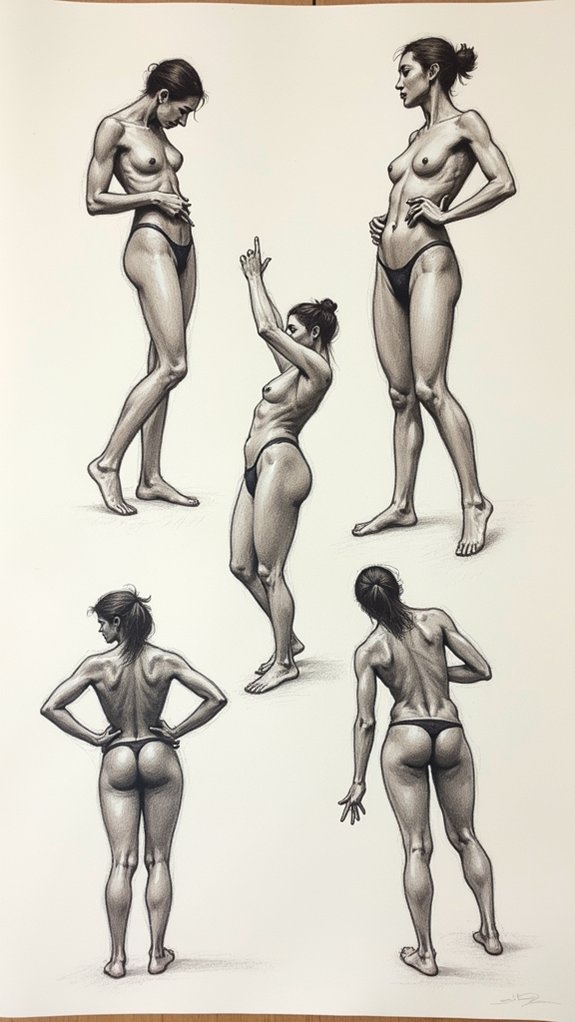
Quick gesture drawing sessions are all about catching movement fast—think of it as trying to freeze a superhero mid-action before they dash away.
With just seconds on the clock, artists learn to simplify forms and focus on the action, not the tiny details (because who has time for fingernails when the clock is ticking?).
The pressure of a timer adds a spark of excitement and really tests how quickly someone can spot those important shapes and lines.
Capturing Movement Rapidly
Imagine trying to catch lightning in a bottle—that’s what quick gesture drawing sessions feel like!
These sketchbook exercises aren’t about perfect details but about grabbing the wild energy of movement before it slips away. With gesture drawing, it’s all about shapes and flow, not fussing over tiny wrinkles or freckles.
Artists dash through timed sketches, maybe in 30 seconds or a few minutes tops, turning hesitant squiggles into bold, confident strokes. Here’s how artists keep things lively:
- Draw dancers, athletes, or rambunctious animals for variety and a real challenge.
- Use continuous line techniques to enhance hand-eye coordination.
- Focus on the biggest shapes first, then add just enough detail to show movement.
- Practice often to strengthen observational skills and fearlessness.
Timing and Spontaneity
How do artists manage to capture the vibe of a moving figure in just a few moments? Quick gesture drawing sessions are their secret weapon. By giving themselves just 30 seconds to two minutes per sketch, artists push for speed and spontaneity.
It’s almost a game—can you sketch the pose before the timer buzzes? With quick sketches like these, perfection isn’t the goal; it’s about grabbing the action and energy, even if the lines get a little wild.
Techniques like continuous line drawing, where the pencil never leaves the paper, help keep the motion loose and real. Themes like “draw someone running” or “sketch a jumping dog” keep things interesting.
Practicing this way regularly builds confidence—plus, it’s surprisingly fun!
Simplifying Forms Effectively
When artists are racing the clock in those lightning-fast gesture drawing sessions, it’s basically all about breaking things down to their simplest shapes. No time for tiny eyelashes—just pure movement and bold forms!
By focusing on gesture drawing, artists can loosen up and actually get braver on paper. Quick sketching like this swaps tangled details for the basics, training the brain to spot big-picture stuff fast. Not only does it make art more fun, but it also helps squash that “what if I mess up” feeling.
Here’s how to keep gesture drawing sessions fresh and effective:
- Use bold, messy tools like charcoal or ink for extra energy.
- Start with 30-second sketches to challenge speed.
- Place focus on capturing movement, not perfection.
- Practice regularly—confidence grows with mileage!
Color Palette Exploration
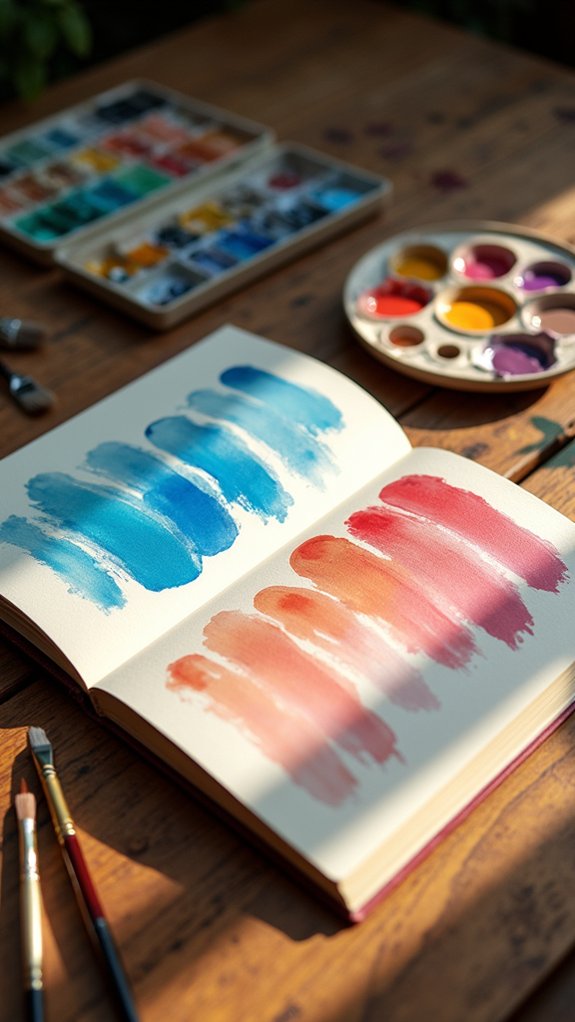
A handful of well-chosen colors can transform an ordinary sketchbook page into something seriously eye-catching, almost like magic. Color palette exploration is all about picking a few colors—maybe just four or five art supplies—and discovering how wildly different your daily drawing can look with each combo. Try grabbing colors inspired by the world around you, like the wild socks your best friend wears or the juicy shades of an apple. Record your favorite mixes in your sketchbook to develop a unique style that’s totally yours.
| Color Palette Idea | What to Try |
|---|---|
| Complementary Colors | Red + Green, Purple + Yellow |
| Analogous Colors | Blue, Teal, Green |
| Nature Inspired | Moss, Bark, Sky Blue |
| Favorite Combos | Pink, Orange, Gold |
Texture Swatching With Mixed Media
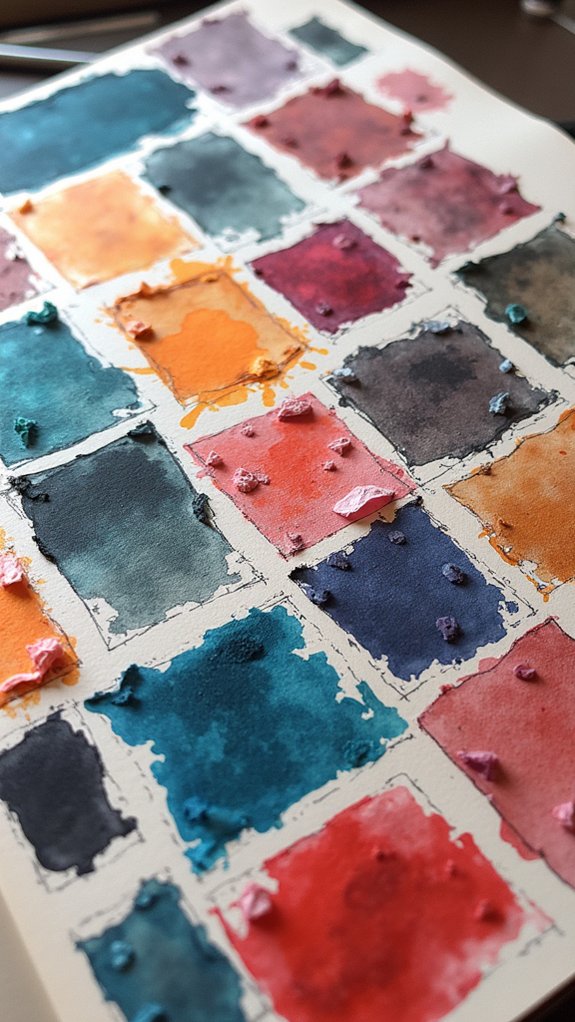
Even though pencils and pens are cool and all, sometimes sketchbook pages just beg for more—like that awesome pop of bumpy, scratchy, or even fuzzy texture you get from mixed media swatching.
Diving into texture swatching is basically giving your page a mini adventure! It means playing with different materials—think watercolor, gel pens, pastels, or even bits of funky paper or fabric. Not only does each tool create its own vibe, but when you mix them up, pure magic happens!
Try these ideas:
- Scrape watercolor with a credit card for a rocky look.
- Stamp bubble wrap in ink for a wild polka-dot texture.
- Layer soft pastels under gel pen scribbles.
- Sponge acrylic paint with bits of old t-shirt.
Label everything—future you will thank you!
One Object, Ten Different Angles
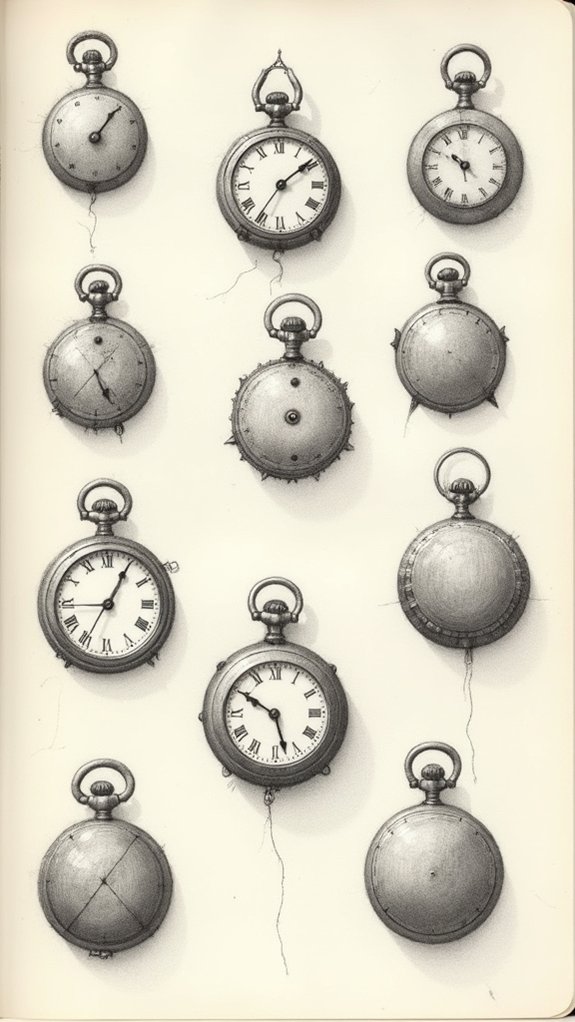
Drawing one object from ten different angles is a wild ride for your brain, because suddenly you’re seeing shapes twist and stretch in ways you never noticed before.
Figuring out how to keep your style looking the same while your object keeps turning—now that’s a challenge, like trying to recognize your best friend in ten different costumes.
But this is where the magic happens: you get better at spotting lines and shadows, and your sketches start to jump off the page with real attitude.
Exploring Form and Perspective
While some people might just sketch an object once and call it a day, there’s actually a ton to discover by drawing the same thing from ten totally different angles.
Exploring form and perspective in your sketchbook helps reveal new ideas and keeps your practice super fresh. When drawing one object—let’s say your favorite cup of coffee—from ten angles, artists start to really see how light dances across surfaces and how shapes shift with each viewpoint.
This exercise is like turning up the volume on your understanding of proportions, dimensions, and the magic of representing three-dimensional things on a two-dimensional page. Plus, it’s perfect for those who get bored quickly.
- Focus on light, shadow, and surface.
- Observe shifting contours and structure.
- Capture texture using colored pencils, ink, or graphite.
- Document daily life objects for creativity boosts.
Challenges in Visual Consistency
After spending time flipping and turning an object to really get a feel for its shape, there’s another tricky part that pops up—keeping everything looking the same in every drawing.
It’s one thing to draw a mug from the left, then the right, then upside down, but, wow, making sure it doesn’t magically turn into a completely different mug each time is a huge test of visual consistency!
Artists have to watch for details like handle placement and shadow shapes, or that mug will start looking like a spaceship.
Practicing this builds keen observation skills and a sharper eye for style.
When artists nail visual consistency, their art feels more real and dynamic—like you could reach right in and grab that mug, no matter the angle.
Urban Sketching: Buildings and Street Scenes
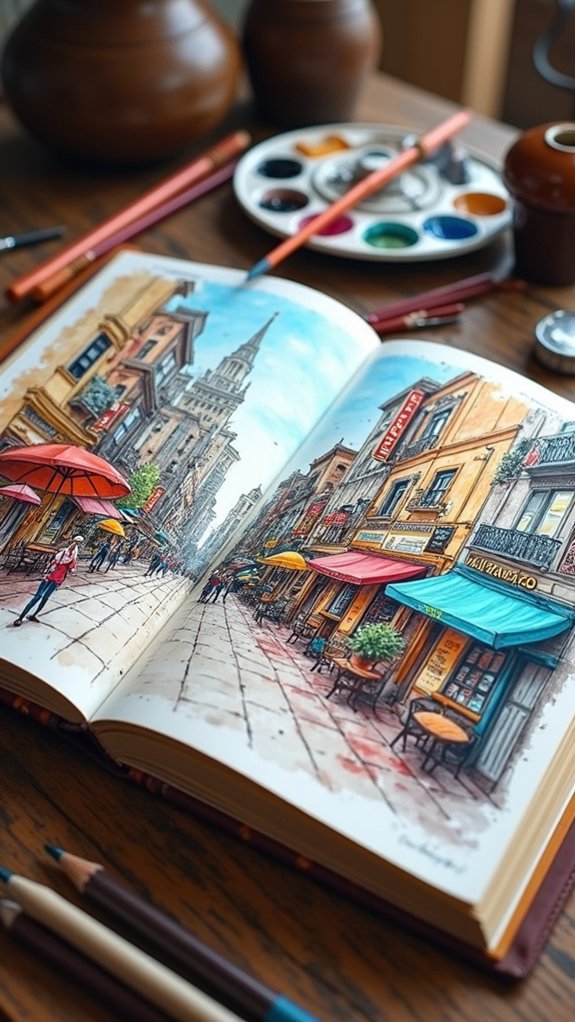
Ever wonder what makes a city feel so alive and buzzing? Urban sketching is the secret sauce! It lets artists grab the energy of busy streets, towering buildings, and the chaos of daily life—all with just a sketchbook and some clever tools.
By playing with different perspectives, like sketching from way up high or right down on the sidewalk, sketches can really pop off the page. Cities change fast, so drawing quick, loose gestures helps capture that movement and keeps the sketches exciting.
Want your work to stand out? Try mixing media—like ink, watercolor, or colored pencils—for cool effects.
Here are four ways to level up your urban sketching game:
- Focus on eye-catching architectural details.
- Play with unusual perspectives.
- Practice speedy, energetic sketches.
- Mix media for extra flair.
Self-Portrait Variations
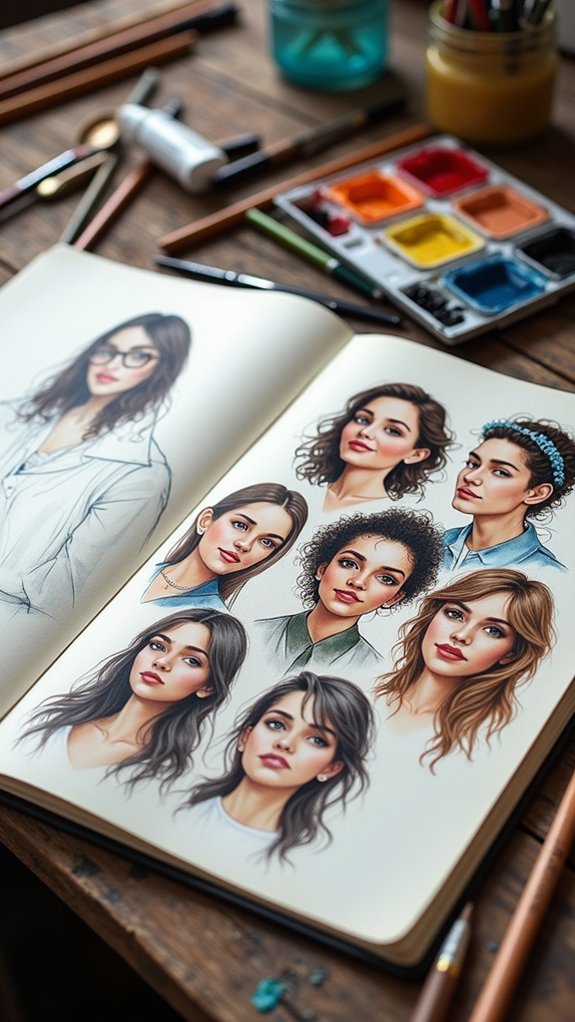
Self-portraits don’t have to be stiff or serious—artists can let loose by trying expressive self-portrait methods, using bold marks, wild colors, or even adding some wacky details to show personality.
It gets even more interesting when skipping the mirror completely and drawing from memory, old photos, or even your reflection in a spoon (expect weird results and maybe a laugh).
These playful approaches not only make creating self-portraits more fun, but also turn each page into a totally unique story about the artist.
Expressive Self-Portrait Methods
Dive headfirst into the wild world of expressive self-portraits, where rules aren’t just meant to be broken—they’re meant to be tossed out the window!
Expressive self-portrait methods in art are full of ideas that help you see yourself in a whole new way, no filter needed. Want to capture your personality, quirks, or even just your current mood? It’s all about experimenting, laughing at mistakes, and getting weird.
Here are four ways to mess with tradition:
- Draw yourself with your eyes closed—feel your face and let your hand do the work!
- Try a collage using fabric scraps or magazine pictures to show more than just your face.
- Go abstract: play with cubism or wild colors to twist up reality.
- Add objects from your room as secret self-symbols.
Nontraditional Mirrorless Portraits
Forget staring at your own reflection—artists can shake things up by creating self-portraits without peeking in a mirror at all. Nontraditional mirrorless portraits get wild!
Imagine trying blind contour drawing: you draw yourself without glancing at the paper. Mistakes? Sure! But that’s where things get fun and unpredictable.
Artists can push the envelope, using stuff like fabric scraps, bits of magazine collage, or even crumpled candy wrappers from their daily life. Abstraction lets emotions and identity shine through in bold color, wacky textures, or meaningful symbols.
Toss in themes, prompts, or daily challenges, and it becomes a personal adventure, marking how you feel or grow day by day. Who needs a mirror when creative freedom is this much fun?
Family and Friends: Capturing Likenesses
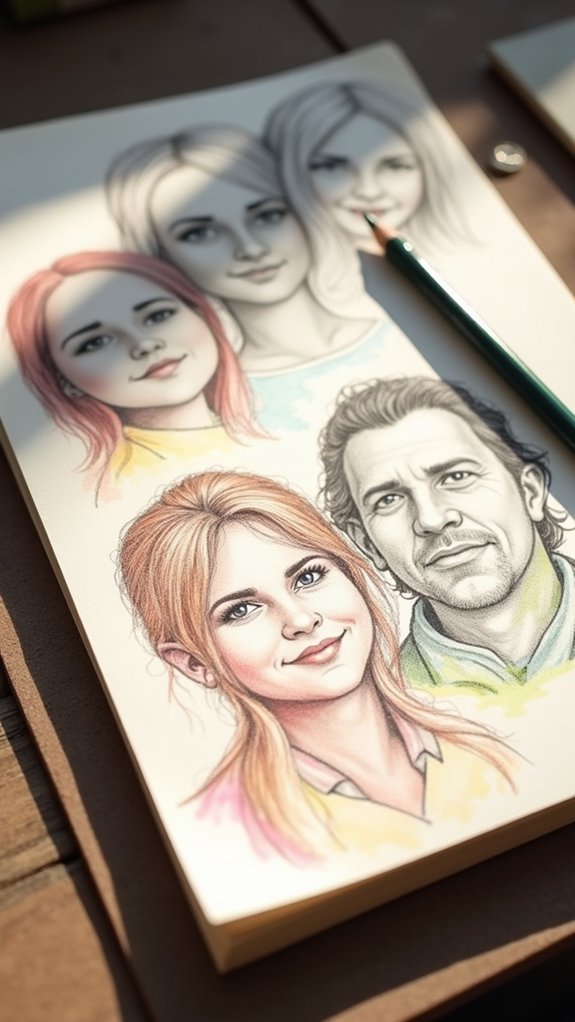
How can someone capture the spark that makes their family and friends so uniquely themselves?
Drawing those closest to you can feel tricky, since you want to get their features just right—but it’s also about painting their vibe onto the page! Artists often start by noticing key things: maybe your brother has a lopsided grin, or your friend always raises one eyebrow.
Using quick sketches can help you catch their energy before they run off to eat or tell jokes again.
Here are four ideas to help you capture family and friends in your sketchbook:
- Notice unique hairstyles and facial features.
- Use the 8-heads tall rule for body proportions.
- Experiment with charcoal for drama or watercolor for softness.
- Practice gesture sketches to grab their personalities fast!
Abstract Art Inspired by Music
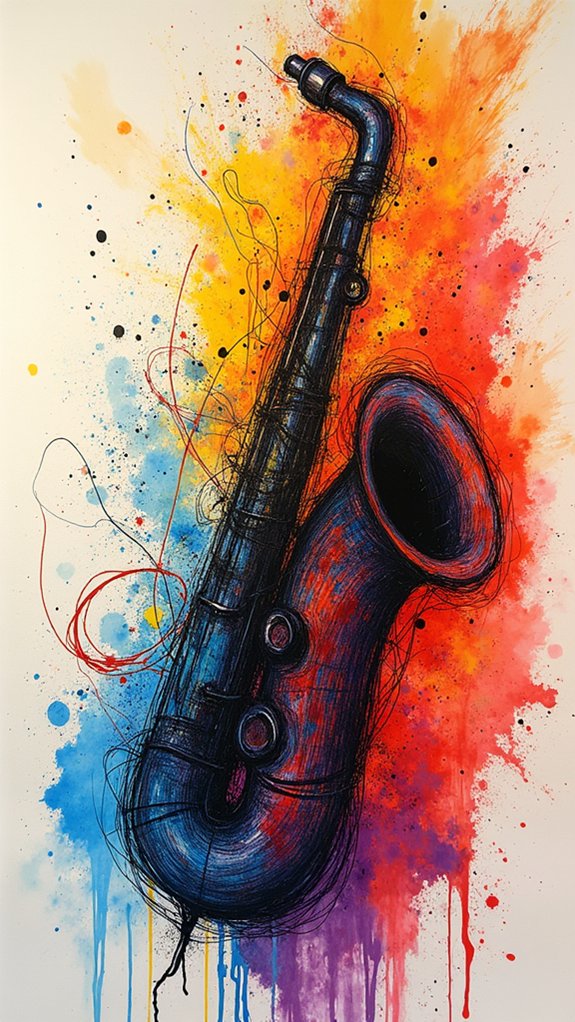
Ever wondered what music might look like if you could see it on paper? Abstract art inspired by music is like turning your playlist into a wild, visual adventure. Artists use lines, colors, and shapes to capture how songs make them feel. Fast beats might become zigzags, while a slow song could flow across the page in dreamy blues and purples. By keeping your sketchbook ready, you can create a whole series based on your favorite albums or try wild experiments, like drawing without looking, letting the rhythm guide your hand. It’s a great way to break art block and see where your imagination goes!
| Music Genre | Possible Colors | Line Styles |
|---|---|---|
| Classical | Soft pastels | Flowing, gentle curves |
| Jazz | Bold primaries | Sharp, zigzagged lines |
| Pop | Bright neons | Bouncy, repeating marks |
Visual Journaling Your Day

After turning music into wild bursts of color and shape, some artists swap the chaos for something a bit more personal—visual journaling their day. They use their daily sketchbook as a place to freeze small moments: that weirdly perfect swirl in their morning coffee or a cat squished into a sunbeam.
This kind of drawing lets them capture memories while practicing their art. Adding little notes or words makes everything feel even more like their own private comic strip about life. Over time, a daily sketchbook turns into a treasure chest packed with experiments, jokes, and surprises.
Here are four ways to jazz up visual journaling your day:
- Sketch one object you use daily
- Draw an emotion you felt
- Write a sentence about today’s highlight
- Capture something you heard
Fantasy Creatures and Invented Animals
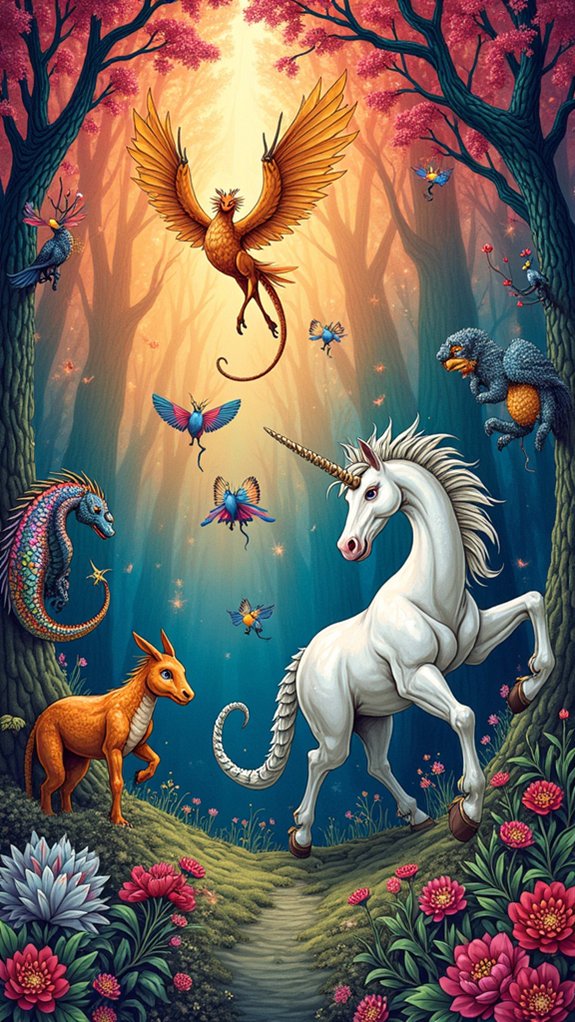
Fantasy creatures and invented animals give artists the perfect excuse to mash up real animal parts with wild, imaginary ideas, like putting a tiger’s teeth on a hummingbird or giving a turtle shimmering, see-through wings.
Exploring unique anatomies can get pretty weird in the best way possible—try sketching outrageously long tails or inventing new types of feet just for fun.
There’s a real rush in seeing how far you can push a creature’s shape and personality while still making it look like it could exist, even if only in the pages of your sketchbook.
Combining Real and Imaginary
When artists start mixing real animals with their wildest ideas, something unexpectedly awesome happens. By combining real and imaginary features, sketches turn simple creatures into totally new fantasy beasts.
This mix can create a bird with cheetah legs or a turtle with rabbit ears—talk about unpredictable! Creating invented animals helps artists stretch their imagination while learning how living things really work. Plus, it’s a sure way to surprise yourself (and maybe freak out a few friends).
Here’s how anyone can start combining real and imaginary elements in their sketchbook:
- Use animal photos as a base, then swap features between species.
- Invent backgrounds and stories for your new creatures.
- Experiment with weird textures and wild color combos.
- Practice drawing creatures in fun poses and places.
Exploring Unique Anatomies
If making up totally new creatures sounds exciting, exploring unique anatomies is the next step for pushing those wild ideas even further.
Imagine what happens when you mix the wings of an eagle with the sprinting legs of a cheetah—suddenly, you’ve got a beast ready to take on both sky and land!
Playing with different styles, like sketching in sharp lines or using soft shading, helps each invented animal look and feel distinct.
Remember to keep some balance—giant bat ears do need a strong enough neck!
Inspiration can strike from legendary creatures too; griffins, mermaids, even jackalopes.
Mix real animal traits, throw in things like camouflage or extra eyes, and don’t worry if they’re a little weird.
That’s where the magic happens!
Hand Lettering and Typography Experiments
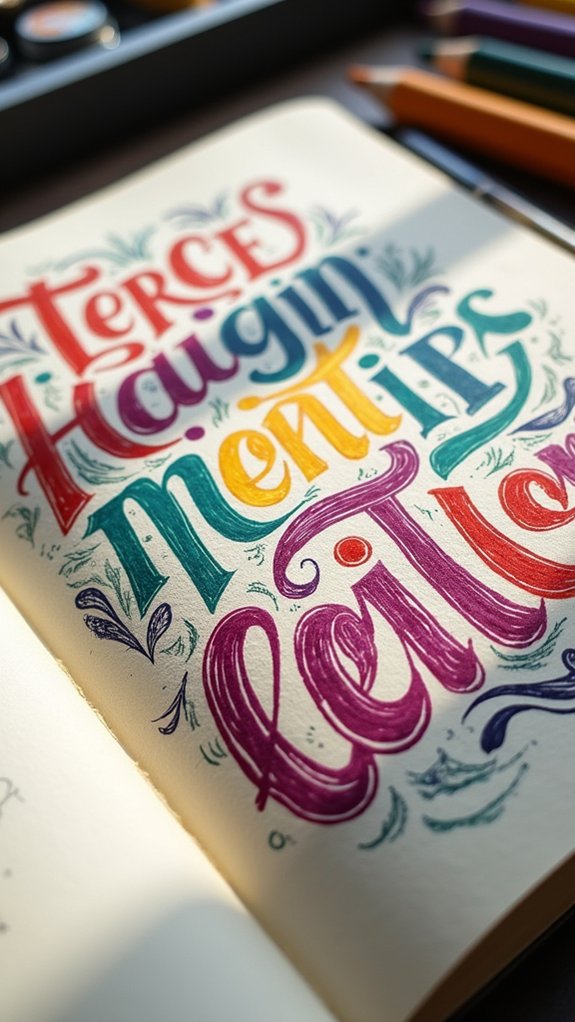
Because letters are everywhere—on signs, in books, even on cereal boxes—hand lettering and typography experiments can feel like revealing a secret superpower.
Trying out hand lettering is way more than just fancy writing. It’s a chance to create your own cool fonts and add meaning to simple words. Plus, there’s something totally satisfying about nailing the perfect curve on a letter “g” or creating a wild swirl on a capital “S.”
Want some ideas to get those creative juices flowing? Check these out:
- Try drawing every letter in a different style on one page.
- Experiment with brush pens versus markers and compare textures.
- Add flourishes, big swirls, or crazy ligatures for extra flair.
- Combine words with simple doodles for epic doodle-letter mashups.
Art Inspired by Favorite Books or Movies
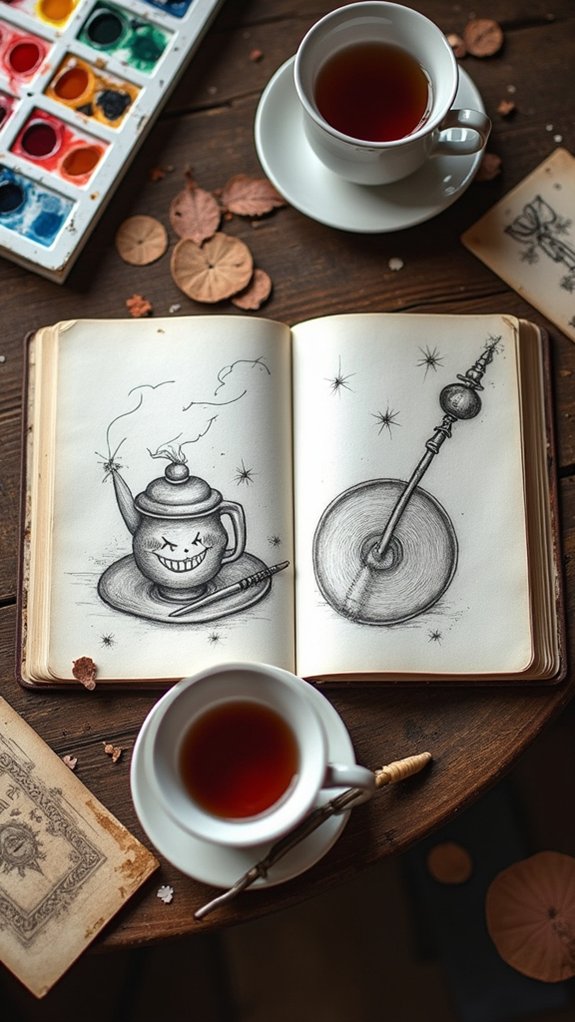
Fonts and fancy letters are awesome, but sketchbook pages can get seriously epic with a bit of book or movie magic. Imagine sketching your favorite wizard with wild hair, or trying to capture that hero’s epic smirk just right.
Art school might teach you technique, but diving into iconic scenes or legendary quotes from stories you love? That’s where the real adventure kicks in.
Try coloring your art with moody palettes inspired by dark forests or glowing galaxies—feelings from the stories will shine right through.
If you’re feeling extra daring, mash up characters from different universes and watch your creativity go wild! Experiment with art styles too, and see how a cartoony villain or a realistic hero can totally change the vibe.
Blind Contour Drawing Challenges
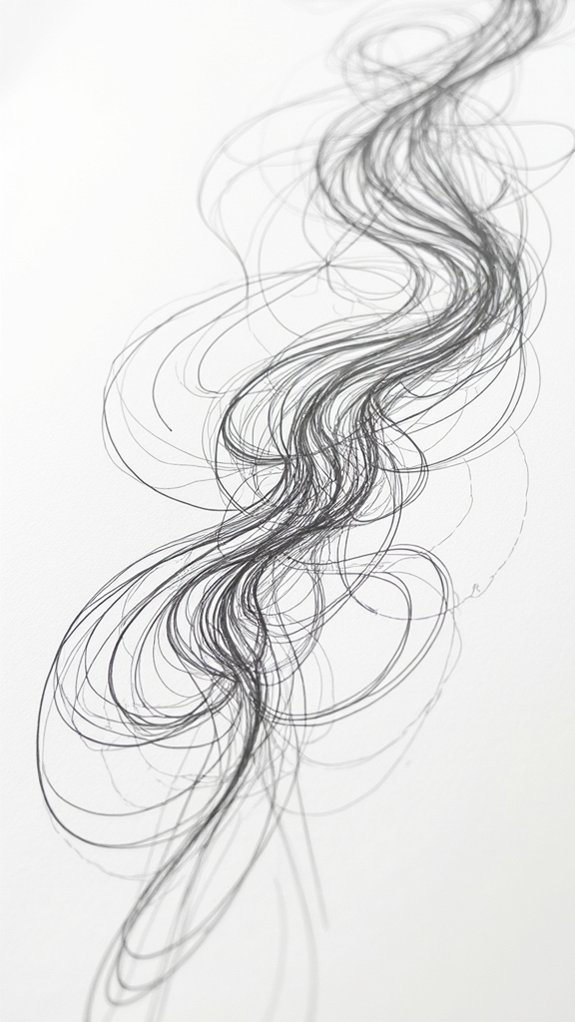
How wild is it to draw something without peeking at your paper, just trusting your eyes and your hand to work together like a secret team?
Blind contour drawing challenges are like a trust fall for your sketchbook skills—you let go of perfection and grab onto pure observation. Suddenly, that simple mug or your friend’s face turns hilariously wonky, but in the best way.
These challenges sharpen your hand-eye coordination, boost your observation powers, and zap your inner critic. Plus, they keep things weird and fresh!
Want some ideas?
- Draw a selfie in under two minutes—no peeking!
- Try a blind contour of your pet mid-yawn.
- Layer in colorful watercolor after your wild line drawing.
- See how many objects you can sketch continuously—no lifting your pen!
Collage Compositions With Found Materials
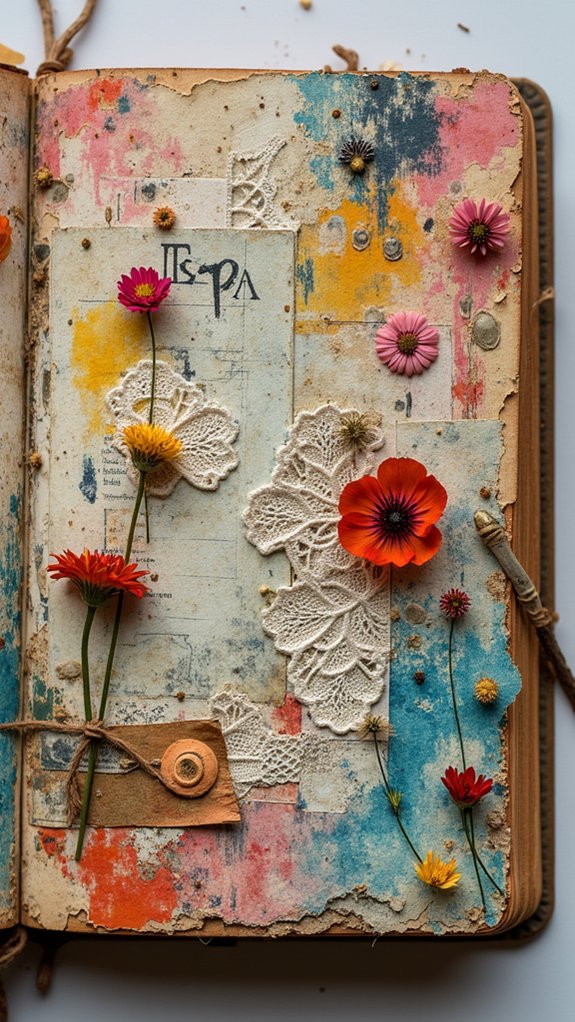
If a sketchbook ever wanted to throw a party, collage with found materials would be the confetti. Collecting magazine clippings, fabric scraps, even bits of colorful wrappers can transform blank pages into wild, textured adventures.
Collage compositions don’t follow strict rules—combine smooth paper with bumpy cloth, tear out dramatic shapes, or stack layers until the page almost bursts. Organizing found materials in a folder or special sketchbook pocket keeps the chaos just tidy enough to be fun.
When piecing everything together, experiment with surprising matches. Will that shiny gum wrapper make a cool hat for a cut-out cat? Why not!
Jotting down what inspired each collage or how it makes you feel turns your sketchbook into a creative diary packed with stories.
Drawing With Non-Dominant Hand
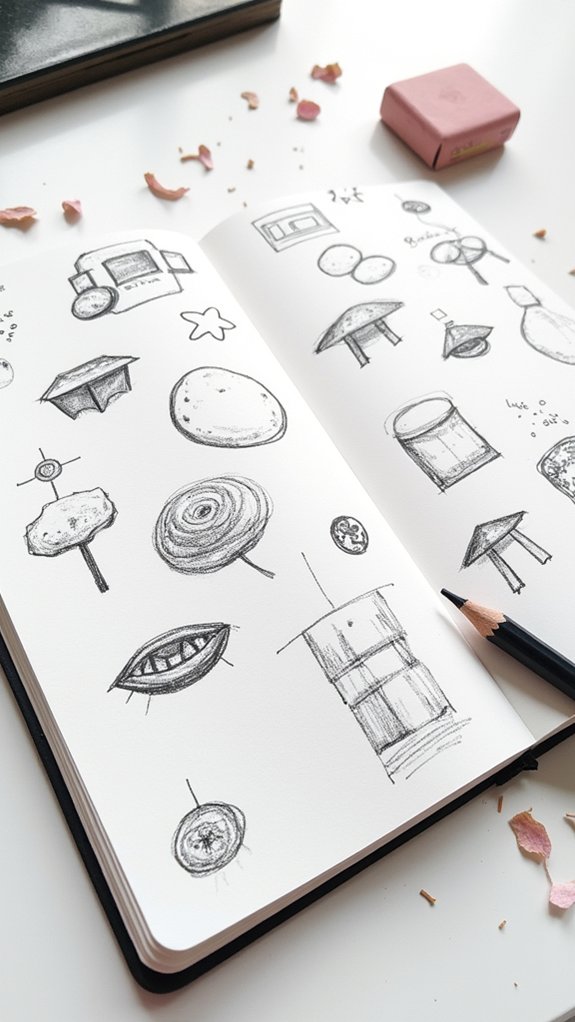
While most people automatically reach for their dominant hand to draw, switching things up and using the “other” hand can turn art time into a hilarious adventure.
Sure, your first attempts might look like the work of a distracted octopus, but that’s the fun! Drawing with your non-dominant hand actually boosts drawing skills in sneaky ways. It challenges the brain, helping you build new neural pathways and improve coordination.
It’s a perfect way to warm up your hand, loosen your grip, and let go of perfectionism. Ready to give it a whirl? Try this:
- Fill one page drawing only with your non-dominant hand.
- Compare sketches and notice the looser, more spontaneous lines.
- Mix non-dominant hand marks with dominant hand doodles.
- Reflect on how this wildly playful exercise shifts your creative thinking!
Timed Drawing Sprints: One Minute Per Sketch
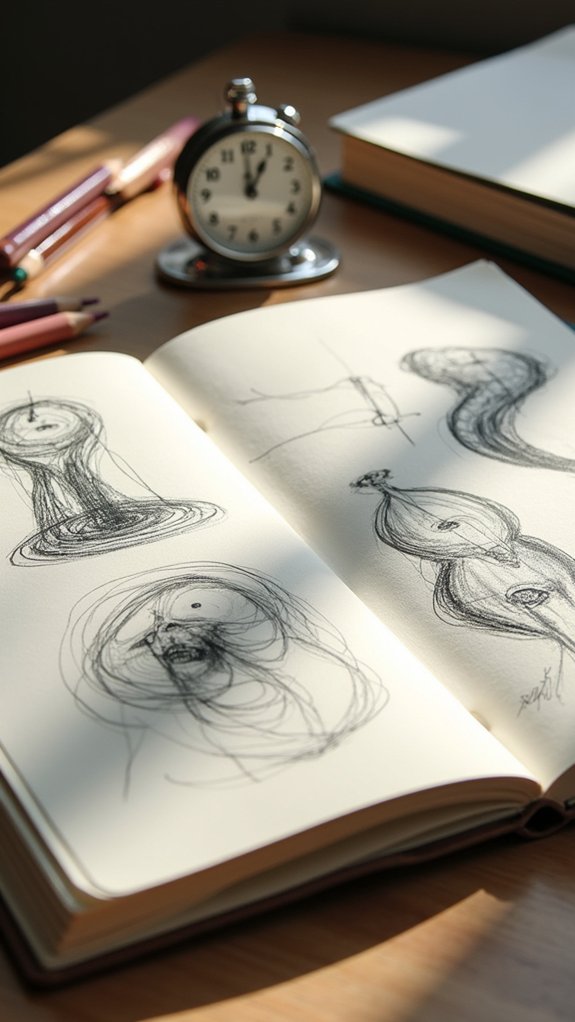
Timed drawing sprints, where you give yourself just one minute per sketch, can supercharge your drawing speed and keep your pencil moving nonstop.
There’s no time for hesitation—your observation skills get sharper by the second, and sometimes your funniest, most creative ideas show up when you least expect them.
It’s fast, a little chaotic, and honestly, kind of hilarious to see what you come up with when you only have sixty seconds on the clock.
Boosting Drawing Speed
Grab a timer, sharpen that pencil, and get ready for a wild minute! Timed drawing sprints are like the roller coaster rides of sketchbook practice—they’re intense, quick, and totally thrilling.
One-minute sketches force artists to draw at lightning speed, focusing less on perfection and more on capturing the core idea. It’s not about being perfect, it’s about being fast and loose!
Want to boost your drawing speed while having fun? Here’s how timed drawing sprints help:
- Train Your Reflexes: Your hand and eye teamwork gets faster and smoother.
- Lose the Overthinking: Speed pushes you to stop worrying and start drawing.
- Express Yourself: Quick sketches release your creative energy.
- Build Confidence: Sprints shift focus to progress, not mistakes.
Enhancing Observation Skills
Getting faster at drawing is awesome, but what if sketching could sharpen your observation skills too? That’s where timed drawing sprints—like those wild, one-minute sketches—come in!
You pick a subject, set a timer, then race the clock, focusing on just the most important shapes and forms. There’s no time to fuss over tiny details: you have to let go of perfection and notice what really matters.
These sprints give your hand-eye coordination a real workout, forcing quick decisions and boosting confidence. One-minute sketches are universal, working for anything from bananas on your kitchen table to friends striking a silly pose.
With each sprint, you get better at seeing, not just drawing. It’s fast, fun, and totally worth the adrenaline!
Encouraging Spontaneous Creativity
Sometimes, creativity shows up when you least expect it—like during a wild race against the clock with just sixty seconds to sketch.
Timed drawing sprints work magic for artists who tend to overthink. There isn’t time to fuss over mistakes or chase perfection; you just grab your pencil and go. The result? A pile of zippy, energetic sketches that really capture the heart of your subject.
This approach makes drawing way less scary and way more fun. Want a quick tip to get started? Set a timer and pick a theme—whatever theme you want! It’s that simple.
- Practice observation by sketching everyday objects in one minute.
- Experiment with different materials and techniques.
- Feel free to make mistakes—perfection isn’t required.
- Sprint often to boost confidence and creative flow.
Documenting Personal Emotions Through Color
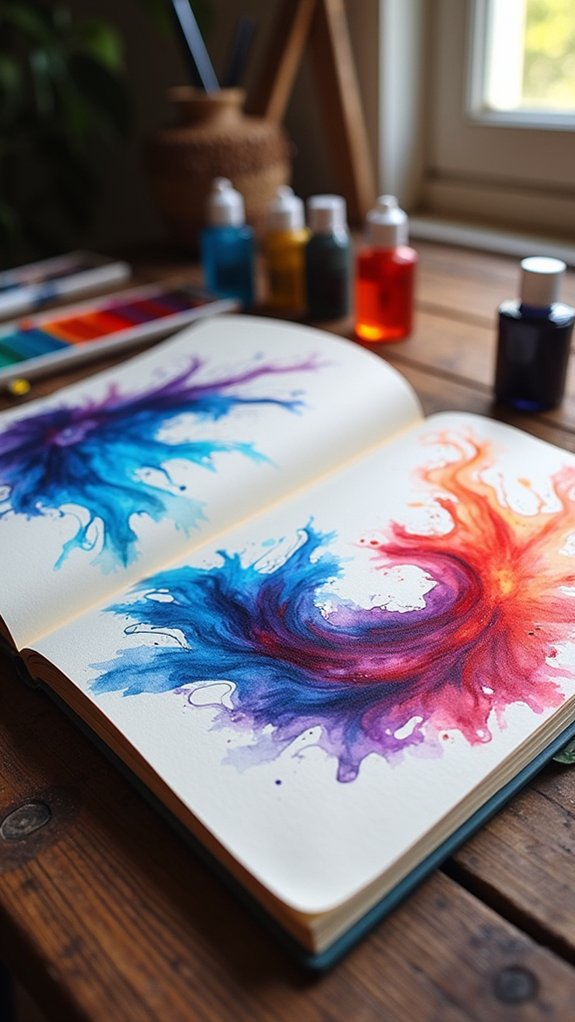
When words just can’t explain what’s brewing inside, color can step in and speak for you. Think about grabbing your colored pencils and letting them do the talking—blue can be a soft sigh of sadness, while yellow might burst with pure happiness.
Create a color palette that feels just right for your mood; maybe bold reds shout excitement, or maybe pale greens whisper calm. Don’t be shy about blending colors, either—life’s emotions rarely stick to one shade.
Mix them up to show complicated feelings, like joy tangled with a hint of worry. Go ahead and play with how bright or dull your colors are, too.
Then, watch your sketchbook pages chart your feelings like a diary, but with color instead of words.
Pattern Design and Repeat Motifs
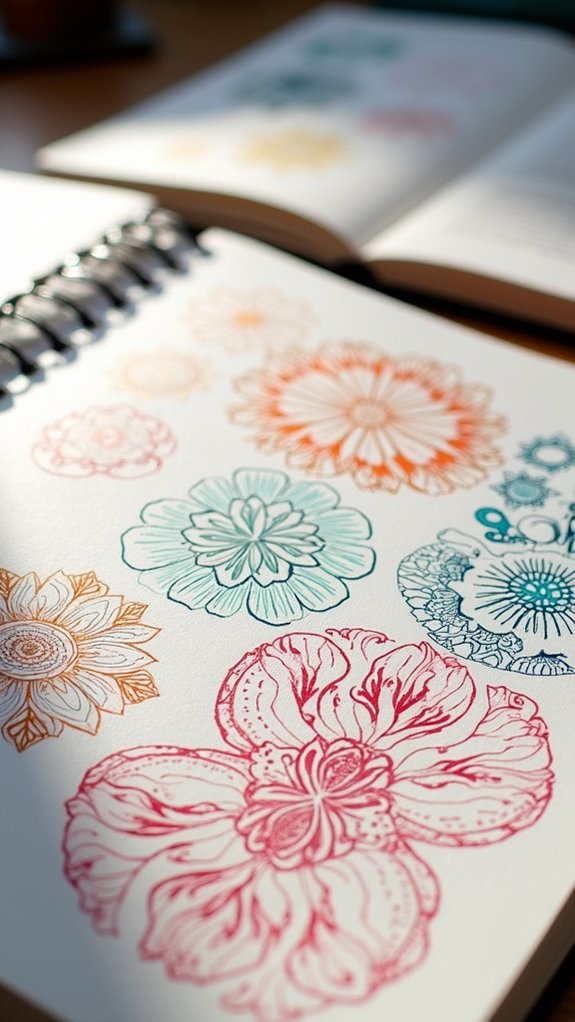
Patterns are like secret codes hidden in everyday things—on clothes, in tiles, even on the cover of a favorite notebook.
Digging into pattern design can be an adventure, mixing repeat motifs to create eye-catching art for everything from phone cases to socks. Patterns aren’t just pretty; they’re teamwork between shapes, colors, and rhythm.
Some jump out, bold and wild, while others whisper, working quietly in the background. Sketchbooks are perfect labs to test these ideas, whether you love doodling wiggly lines by hand or clicking your way on a computer.
Want to give it a try? Here are some ways to start:
- Fill a page with one shape, changing its colors.
- Use stencils to create repeat motifs.
- Mix digital and hand-drawn patterns.
- Experiment with different scales and layouts.
Exploring Shadows and Reflections
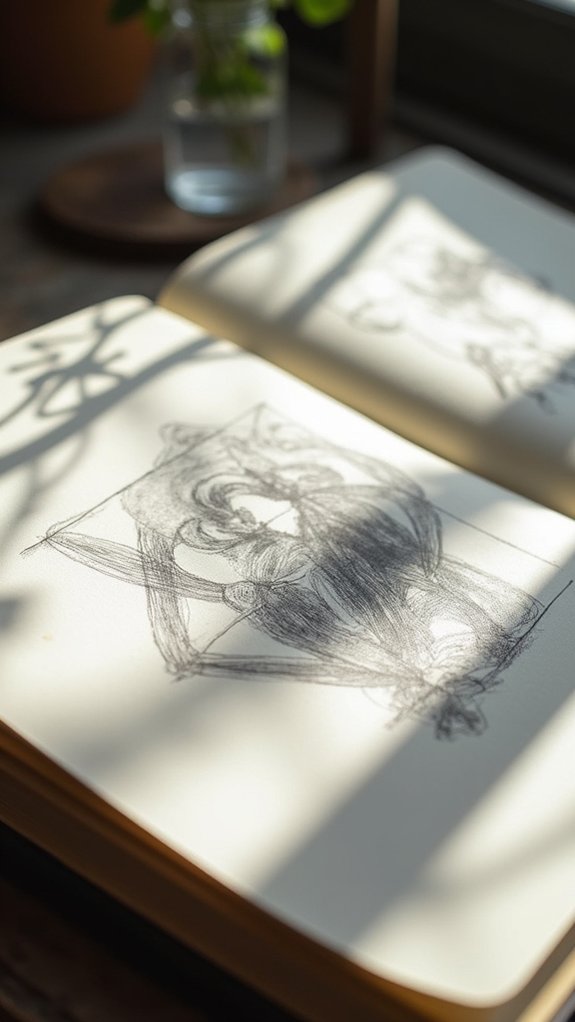
After experimenting with patterns and repeat shapes, things can get even more interesting by chasing the way light plays tricks on the world. Shadows stretch and warp, sometimes sharp, sometimes soft, all depending on where the light hits. Then there are reflections—caught in puddles, glass, even that spoon you left on your desk. Sketching these can be like solving a fun, tricky puzzle. A table can help organize what to look for when experimenting:
| Light Source | Shadow Quality | Reflection Surface |
|---|---|---|
| Sunlight | Crisp, defined edges | Water (ripples, waves) |
| Lamp | Soft, fuzzy edges | Glass (windows, jars) |
| Candle | Flickering, shifting | Metal (spoons, coins) |
| Overcast sky | Barely visible | Shiny plastic |
Drawing shadows and reflections helps train your eye—and makes any sketchbook way more awesome.
Imaginative Storyboard Panels
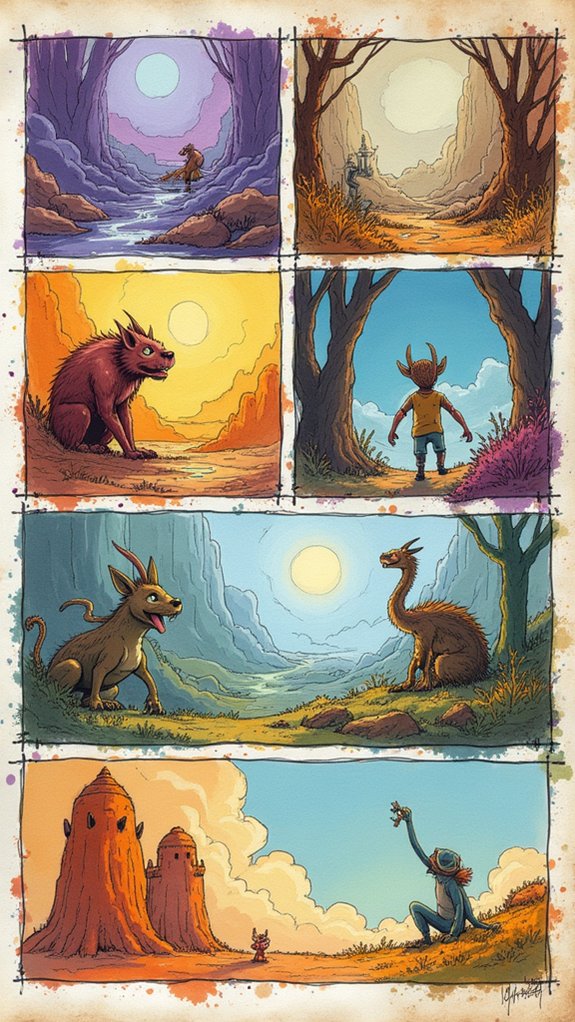
Even if someone’s not planning to make a blockbuster movie, doodling imaginative storyboard panels can seriously level up any sketchbook game.
With storyboard panels, artists become directors of their own little worlds, visually telling epic tales or silly scenes right on the page. It’s a playground for practicing storytelling, character poses, and timing, all while switching up the look of each page.
For anyone feeling stuck or bored with regular drawings, here are some ways to make storyboard panels extra awesome:
- Mix up panel sizes—use giant boxes for big moments and tiny ones for quick actions.
- Show characters reacting dramatically to add excitement.
- Add captions or speech bubbles for punchy dialogue.
- Use creative layouts, like zigzagging panels or overlapping scenes, for maximum energy.
Copying a Masterwork in Your Style
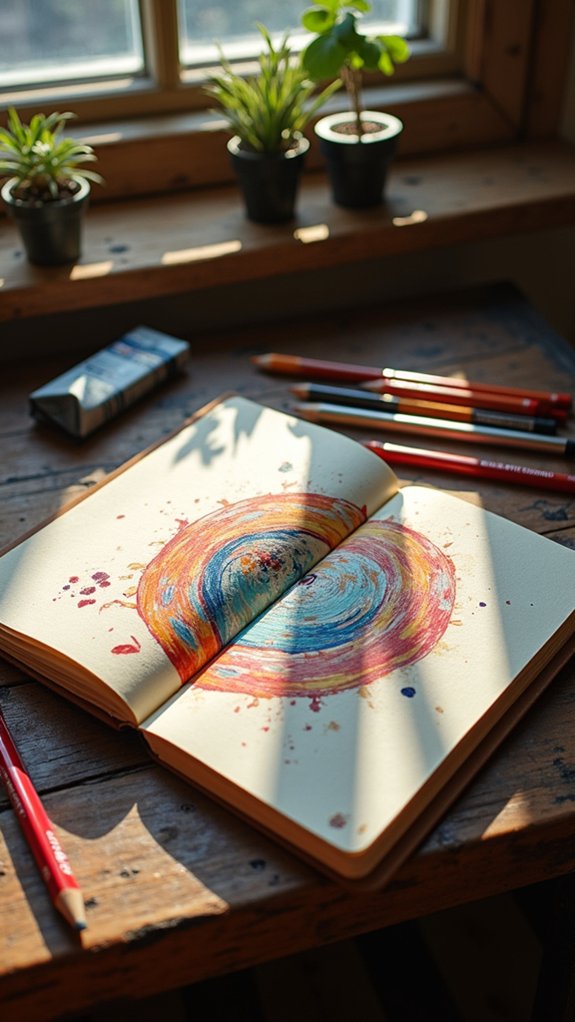
When someone sets out to copy a masterwork in their own style, they’re basically stepping into the shoes of an art legend for a day—and who wouldn’t want to know what that feels like?
Copying a masterwork is like having a one-on-one art lesson with someone like van Gogh or Picasso. By paying attention to line quality, shading, and brushwork, artists can reveal the secrets behind famous pieces while mixing in their own creative twist.
It isn’t about tracing or cloning; it’s about understanding and then making it yours. Some people even set a goal to tackle a new masterwork every month—talk about leveling up!
Keeping a log of choices and experiments reveals progress, plus some pretty funny “happy accidents” along the way.
Creating Postcard-Sized Mini Sketches
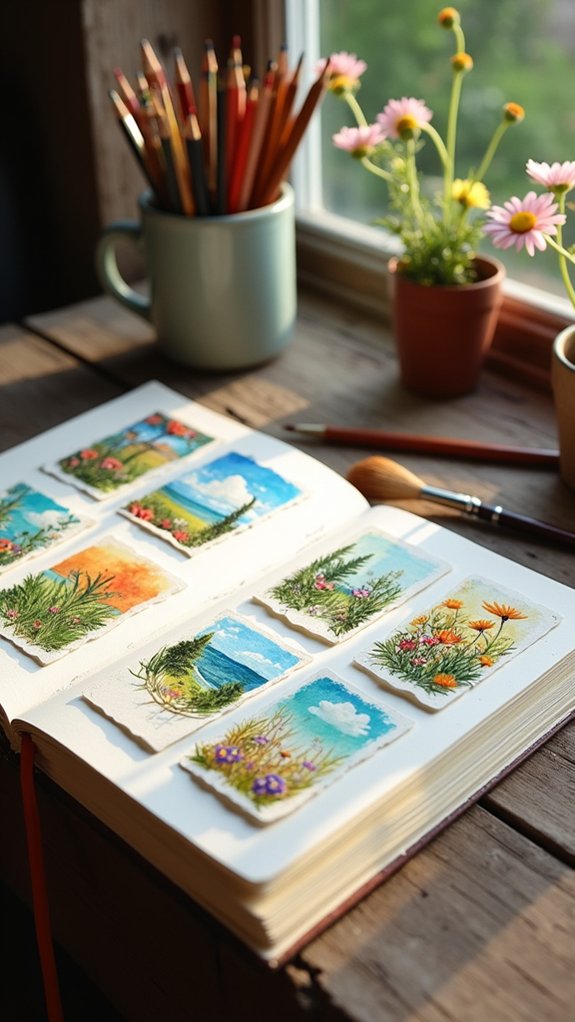
Tiny but mighty—postcard-sized mini sketches pack a surprising punch for any artist’s sketchbook. Their small size, usually around 4″x6″ or 5″x7″, makes them a breeze to engage with, even if you just have a few spare minutes.
Forget the pressure of a giant blank page—these little canvases invite experimentation, quick doodles, and wild ideas. Whether you want to try wild patterns, random doodles, or scenes outside your window, mini sketches let you jump right in. Plus, why not put your art out in the world as actual postcards for friends?
Here are four cool ways to supercharge your postcard-sized mini sketches:
- Draw different things like objects, scenes, or patterns.
- Mix up materials; watercolor, ink, and colored pencils work great.
- Try capturing moments lightning-fast.
- Send your masterpieces as real postcards!
Frequently Asked Questions
How to Have a Sketchbook Practice?
Developing a sketchbook practice involves establishing a consistent routine, keeping tools accessible, and limiting materials. Regular engagement with diverse sketchbook themes, exploring subjects and techniques, helps document progress, supports artistic growth, and maintains enthusiasm throughout the creative journey.
How Can I Make My GCSE Art Sketchbook Better?
To improve a GCSE art sketchbook, a student should explore diverse art techniques, experiment with various mediums, include process notes, and conduct artist studies. This approach demonstrates growth, creativity, and depth, strengthening overall assessment outcomes.
How Do You Preserve Sketchbook Pages?
To guarantee page protection and preservation of sketchbook pages, one should use fixative sprays on dry media, apply acrylic medium for mixed media, store sketchbooks properly, utilize archival materials, and consider page protectors or clear sleeves for delicate works.
What to Sketch to Practice Drawing?
When considering what to sketch to practice drawing, one can focus on character studies, observational sketches of daily objects, gesture drawings, and still life. These varied subjects help build fundamental skills, enhance observation, and encourage creative exploration.
Conclusion
So, with these 24 sketchbook page ideas, artists never have to face a boring, empty spread again. Whether it’s drawing sandwiches, sneaky bugs, or wild color combos, there’s always something new to try. Mistakes? Totally allowed—they just mean you’re trying. Some pages will look cool, others might belong in a secret vault. That’s the fun. Sketchbooks are for mess-ups, surprises, and laughs. So grab those pencils and jump in—your next favorite page is waiting!

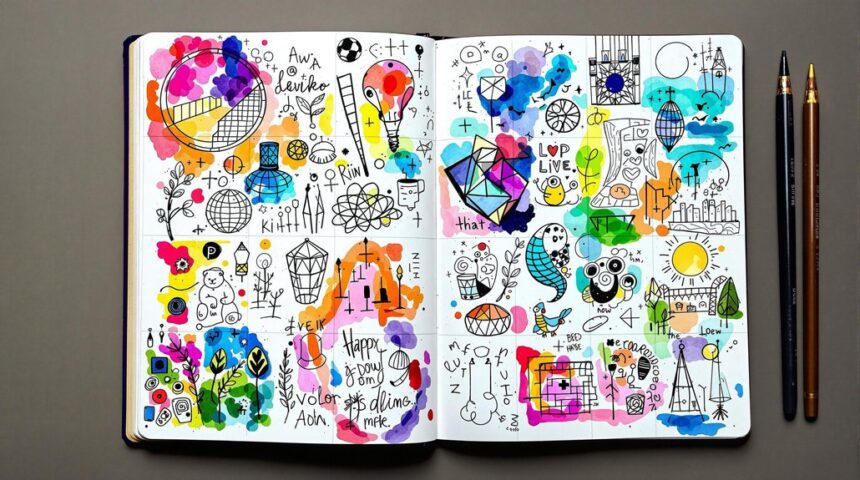
Leave a Reply